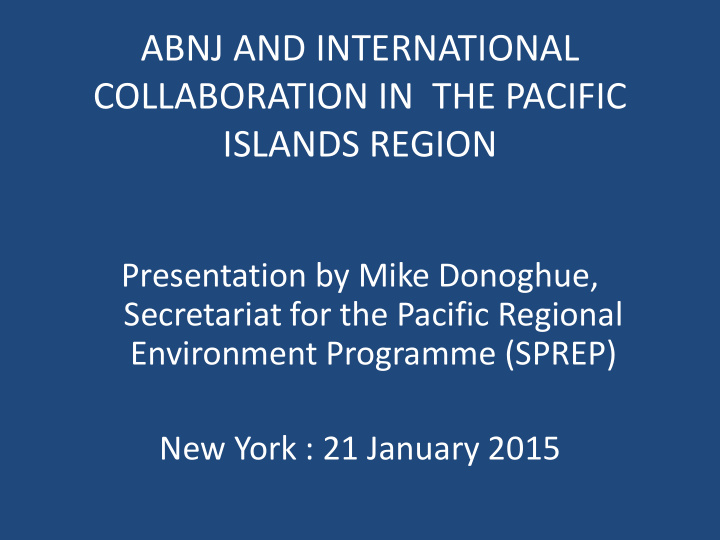



ABNJ AND INTERNATIONAL COLLABORATION IN THE PACIFIC ISLANDS REGION Presentation by Mike Donoghue, Secretariat for the Pacific Regional Environment Programme (SPREP) New York : 21 January 2015
MAIN POINTS OF PRESENTATION • Characteristics of the Pacific Islands Region • Threatened and migratory species • Fisheries in the region – EEZs and ABNJ • Range of MPAs and Sanctuaries in the region • Pacific Oceanscape – a unifying framework for sustainable management of our ocean
NOUMEA CONVENTION
• Some 38 million sq km; • World’s largest tuna fishery, worth over $4 billion annually; • Threatened and endangered species of whales, dolphins, turtles, dugong and sharks; • 30,000 diverse islands and 1000 languages; • An area larger than the moon.
EEZ Area 98%
82% EEZ 18% ABNJ
Humpback whale migrations 4 3
• A unified regional strategy • 5-year plans • Third iteration • Themes, objectives, actions • Indicators
Sharks in the Pacific Islands • Many are threatened and migratory; • Populations have declined significantly in the SPREP region in recent years, but fisheries agencies have been ineffective in halting this decline; • SPREP members are leading the way in declaring shark sanctuaries and promoting shark tourism; • Several Pacific Island countries are members of CITES and/or CMS and SPREP is the regional coordinating agency for CMS and CITES.
PACIFIC ISLANDS TUNA FISHERIES
Pacific Islands EEZs and High Seas Enclaves Equator 12
Regional Initiatives - MPAs and Sanctuaries
“ In our Pacific Islands Ocean region the ocean unites and divides, connects and separates, sustains and threatens our very survival. For all those who venture within this, the world’s largest ocean, and who have made it their home, the ocean influences every aspect of life. It has done so for millennia.” (Anote Tong – President of Kiribati) Fa’afetai lava - Thank you
Recommend
More recommend